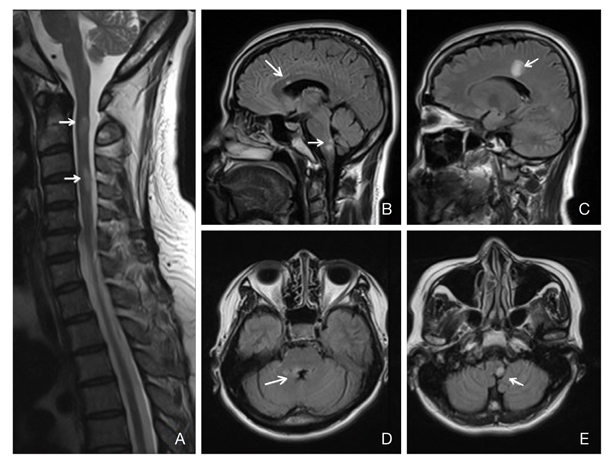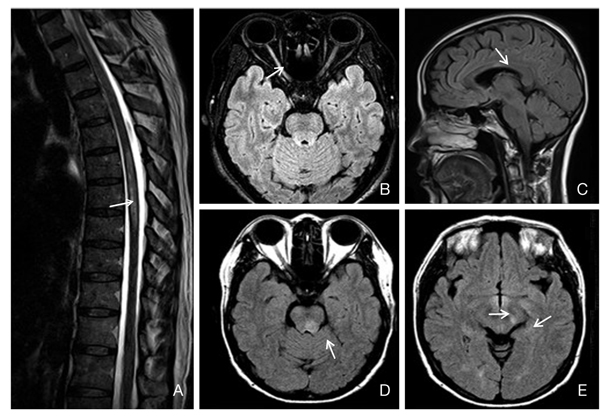J Korean Med Assoc.
2013 Aug;56(8):702-708. 10.5124/jkma.2013.56.8.702.
Multiple sclerosis
- Affiliations
-
- 1Department of Neurology, Asan Medical Center, University of Ulsan College of Medicine, Seoul, Korea. kkkim@amc.seoul.kr
- KMID: 1847872
- DOI: http://doi.org/10.5124/jkma.2013.56.8.702
Abstract
- Multiple sclerosis (MS) is the most common demyelinating disease affecting the central nervous system of young adults living in the western world. MS should be strongly suspected when a young adult develops one or more neurological episodes consistent with damage to white matter within the central nervous system (CNS), especially when these affect the optic nerves, brainstem, or spinal cord. The patient with relapses, each of which can be attributed to demyelination in the CNS, requires no investigation prior to establishing the diagnosis of clinically definite MS. For a diagnosis of MS, separate anatomical sites within the CNS must have been affected on different occasions, typically three. MS in Asian populations is characterized by the selective and dominant involvement of the optic nerve and spinal cord with some incidence of brainstem lesions. 35-40% of MS cases in Korea are of this optico-spinal type with or without brainstem lesions. Reported cases of neuromyelitis optica spectrum disease (NMOSD), causing severe optic neuritis (ON) and/or longitudinally extensive transverse myelitis, either monophase or with a relapse-remitting pattern, some of which were diagnosed previously as the optico-spinal form of MS in Asia, have increased annually in Korea with the development of the NMO-IgG or aquaporin4-antibody detecting technique. NMO-IgG detection is very important in the diagnosis of early stage of NMOSD and the differentiation of MS and other demyelinating disease. Many new convenient oral drugs or very potent intravenous monoclonal antibodies for targeting VLA-4, CD20, and CD52 may decrease the annual relapse rate and burden of brain-spinal cord lesionsin MS.
Keyword
MeSH Terms
-
Antibodies, Monoclonal
Asia
Asian Continental Ancestry Group
Brain Stem
Central Nervous System
Demyelinating Diseases
Humans
Incidence
Integrin alpha4beta1
Korea
Multiple Sclerosis
Myelitis, Transverse
Neuromyelitis Optica
Optic Nerve
Optic Neuritis
Recurrence
Spinal Cord
Western World
Young Adult
Antibodies, Monoclonal
Integrin alpha4beta1
Figure
Reference
-
1. Hemmer B, Archelos JJ, Hartung HP. New concepts in the immunopathogenesis of multiple sclerosis. Nat Rev Neurosci. 2002; 3:291–301.
Article2. Swingler RJ, Compston DA. The morbidity of multiple sclerosis. Q J Med. 1992; 83:325–337.3. Kim W, Kim HJ. Multiple sclerosis. J Korean Med Assoc. 2009; 52:665–676.
Article4. Yu YL, Woo E, Hawkins BR, Ho HC, Huang CY. Multiple sclerosis amongst Chinese in Hong Kong. Brain. 1989; 112(Pt 6):1445–1467.
Article5. Kira J. Multiple sclerosis in the Japanese population. Lancet Neurol. 2003; 2:117–127.
Article6. Compston A. The diagnosis of multiple sclerosis. In : McAlpine D, Compston A, Confavreux C, Lassmann H, McDonald I, editors. McAlpine's multiple sclerosis. 4th ed. New York: Churchill Livingston;2006. p. 351–388.7. Nakashima I, Fujihara K, Miyazawa I, Misu T, Narikawa K, Nakamura M, Watanabe S, Takahashi T, Nishiyama S, Shiga Y, Sato S, Weinshenker BG, Itoyama Y. Clinical and MRI features of Japanese patients with multiple sclerosis positive for NMO-IgG. J Neurol Neurosurg Psychiatry. 2006; 77:1073–1075.
Article8. Wingerchuk DM, Lennon VA, Lucchinetti CF, Pittock SJ, Weinshenker BG. The spectrum of neuromyelitis optica. Lancet Neurol. 2007; 6:805–815.
Article9. Lennon VA, Kryzer TJ, Pittock SJ, Verkman AS, Hinson SR. IgG marker of optic-spinal multiple sclerosis binds to the aquaporin-4 water channel. J Exp Med. 2005; 202:473–477.
Article10. Lennon VA, Wingerchuk DM, Kryzer TJ, Pittock SJ, Lucchinetti CF, Fujihara K, Nakashima I, Weinshenker BG. A serum auto-antibody marker of neuromyelitis optica: distinction from multiple sclerosis. Lancet. 2004; 364:2106–2112.
Article11. Kim KK. Optico-spinal multiple sclerosis and neuromyelitis optica. J Korean Neurol Assoc. 2006; 24:Supp 1. 66–69.12. Carroll W, Saida T, Kim H, Kira J, Kermode A, Tsai C, Fujihara K, Kusunoki S, Tanaka M, Kim K, Bates D. A guide to facilitate the early treatment of patients with idiopathic demyelinating disease (multiple sclerosis and neuromyelitis optica). Mult Scler. 2013; 01. 16. [Epub]. DOI: 10.1177/1352458512471092.
Article13. Polman CH, Reingold SC, Banwell B, Clanet M, Cohen JA, Filippi M, Fujihara K, Havrdova E, Hutchinson M, Kappos L, Lublin FD, Montalban X, O'Connor P, Sandberg-Wollheim M, Thompson AJ, Waubant E, Weinshenker B, Wolinsky JS. Diagnostic criteria for multiple sclerosis: 2010 revisions to the McDonald criteria. Ann Neurol. 2011; 69:292–302.
Article14. McLean BN, Luxton RW, Thompson EJ. A study of immunoglobulin G in the cerebrospinal fluid of 1007 patients with suspected neurological disease using isoelectric focusing and the Log IgG-Index: a comparison and diagnostic applications. Brain. 1990; 113(Pt 5):1269–1289.
Article15. Montalban X, Tintore M, Swanton J, Barkhof F, Fazekas F, Filippi M, Frederiksen J, Kappos L, Palace J, Polman C, Rovaris M, de Stefano N, Thompson A, Yousry T, Rovira A, Miller DH. MRI criteria for MS in patients with clinically isolated syndromes. Neurology. 2010; 74:427–434.
Article16. Bagnato F, Jeffries N, Richert ND, Stone RD, Ohayon JM, McFarland HF, Frank JA. Evolution of T1 black holes in patients with multiple sclerosis imaged monthly for 4 years. Brain. 2003; 126(Pt 8):1782–1789.
Article17. Miller DH, Rudge P, Johnson G, Kendall BE, Macmanus DG, Moseley IF, Barnes D, McDonald WI. Serial gadolinium enhanced magnetic resonance imaging in multiple sclerosis. Brain. 1988; 111(Pt 4):927–939.
Article18. Compston A. Disease-modifying treatments in multiple sclerosis. In : McAlpine D, Compston A, Confavreux C, Lassmann H, McDonald I, editors. McAlpine's multiple sclerosis. 4th ed. New York: Churchill Livingston;2006. p. 729–810.19. Croze E, Yamaguchi KD, Knappertz V, Reder AT, Salamon H. Interferon-beta-1b-induced short- and long-term signatures of treatment activity in multiple sclerosis. Pharmacogenomics J. 2012; 06. 19. [Epub]. DOI: 10.1038/tpj.2012.27.
Article20. Kappos L, Radue EW, O'Connor P, Polman C, Hohlfeld R, Calabresi P, Selmaj K, Agoropoulou C, Leyk M, Zhang-Auberson L, Burtin P. FREEDOMS Study Group. A placebo-controlled trial of oral fingolimod in relapsing multiple sclerosis. N Engl J Med. 2010; 362:387–401.
Article21. Oh J, O'Connor PW. An update of teriflunomide for treatment of multiple sclerosis. Ther Clin Risk Manag. 2013; 9:177–190.22. Killestein J, Rudick RA, Polman CH. Oral treatment for multiple sclerosis. Lancet Neurol. 2011; 10:1026–1034.
Article23. Polman CH, O'Connor PW, Havrdova E, Hutchinson M, Kappos L, Miller DH, Phillips JT, Lublin FD, Giovannoni G, Wajgt A, Toal M, Lynn F, Panzara MA, Sandrock AW. AFFIRM Investigators. A randomized, placebo-controlled trial of natalizumab for relapsing multiple sclerosis. N Engl J Med. 2006; 354:899–910.
Article
- Full Text Links
- Actions
-
Cited
- CITED
-
- Close
- Share
- Similar articles
-
- Reduction of Disease Activity in Patient with Relapsing-Remitting Multiple Sclerosis after Switching to Teriflunomide from Interferon Beta
- A Case of Multiple Sclerosis in Child Showing Homonymous Hemianopia
- Analgesia for Labor in a Parturient with Multiple Sclerosis: A case report
- A Case of Unilateral Renal Angiomyolipoma Associated with Tuberous Sclerosis
- Chronic Cerebrospinal Venous Insufficiency in Multiple Sclerosis: A Failed Concept



